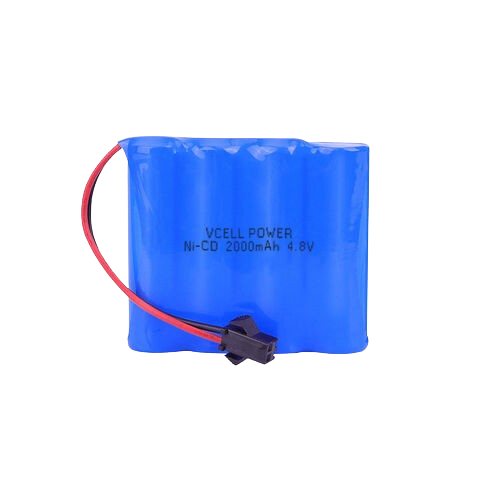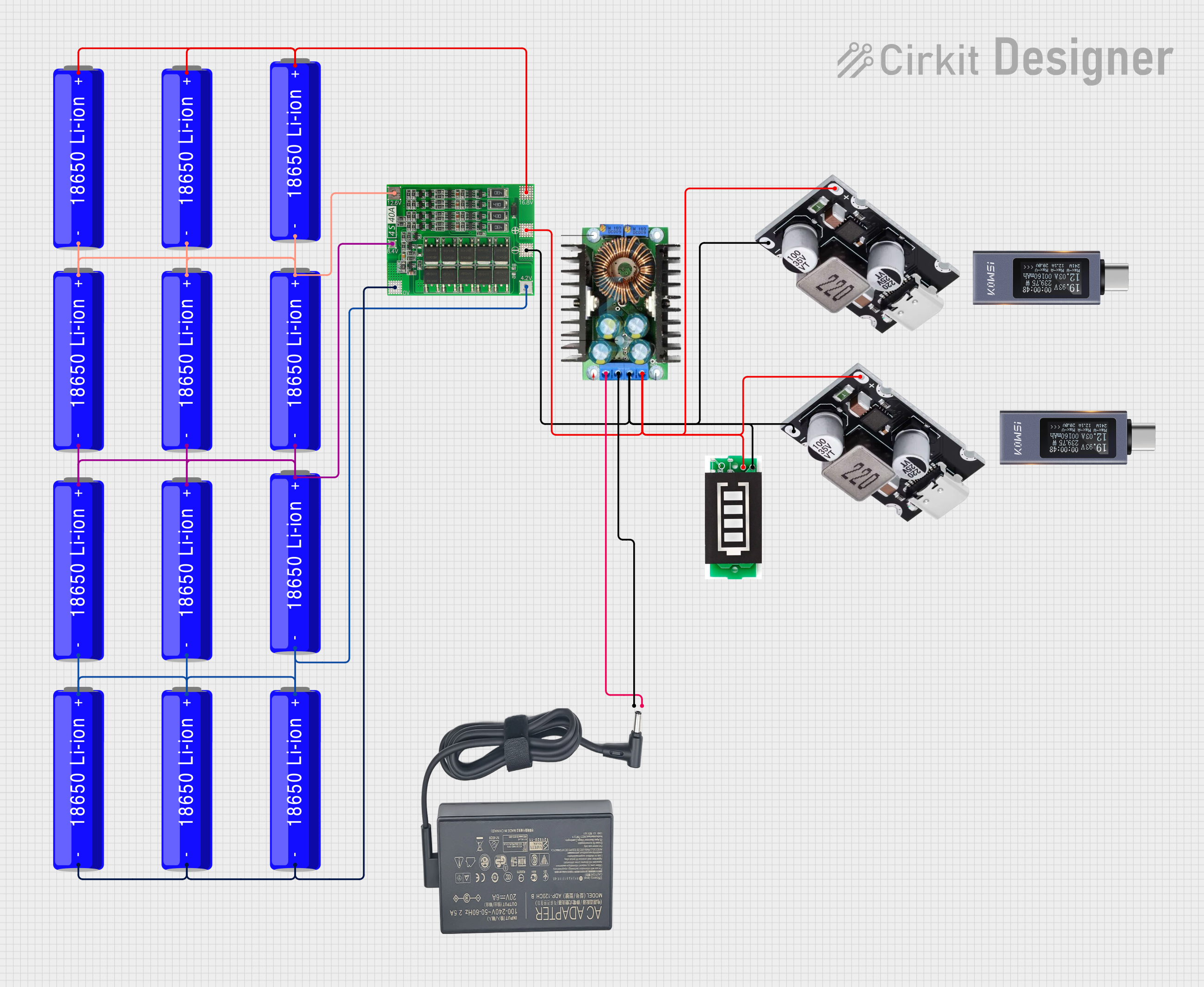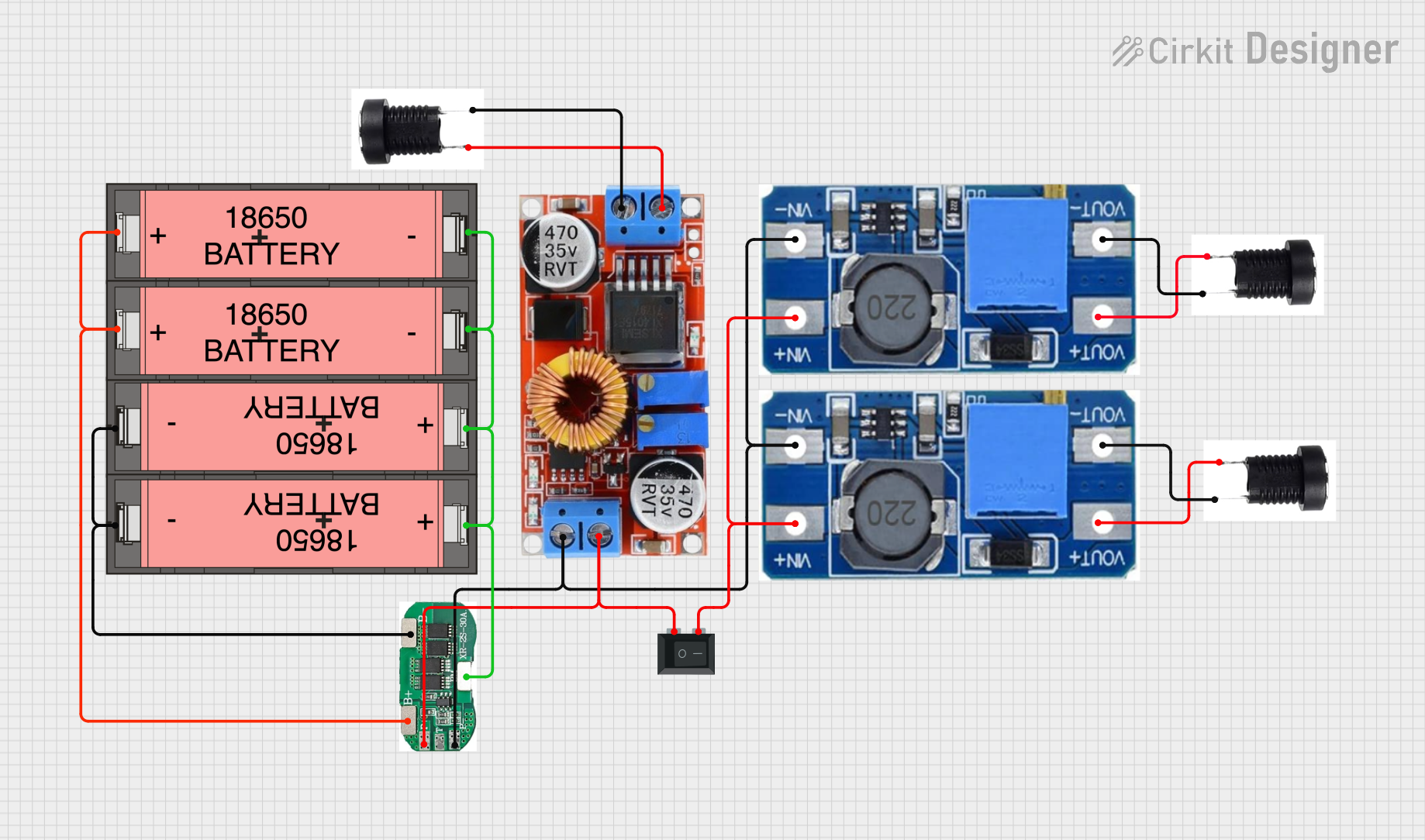
How to Use 4.8V 2000mAh Lithium Ion Battery: Examples, Pinouts, and Specs

 Design with 4.8V 2000mAh Lithium Ion Battery in Cirkit Designer
Design with 4.8V 2000mAh Lithium Ion Battery in Cirkit DesignerIntroduction
The 4.8V 2000mAh Lithium Ion Battery is a rechargeable power source designed to deliver a nominal voltage of 4.8 volts and a capacity of 2000 milliamp hours (mAh). Manufactured by Lithium Ion Battery, this component is ideal for applications requiring reliable and long-lasting energy storage. Its compact size and high energy density make it suitable for powering a wide range of electronic devices, including portable gadgets, robotics, and backup power systems.
Explore Projects Built with 4.8V 2000mAh Lithium Ion Battery

 Open Project in Cirkit Designer
Open Project in Cirkit Designer
 Open Project in Cirkit Designer
Open Project in Cirkit Designer
 Open Project in Cirkit Designer
Open Project in Cirkit Designer
 Open Project in Cirkit Designer
Open Project in Cirkit DesignerExplore Projects Built with 4.8V 2000mAh Lithium Ion Battery

 Open Project in Cirkit Designer
Open Project in Cirkit Designer
 Open Project in Cirkit Designer
Open Project in Cirkit Designer
 Open Project in Cirkit Designer
Open Project in Cirkit Designer
 Open Project in Cirkit Designer
Open Project in Cirkit DesignerCommon Applications and Use Cases
- Portable electronic devices (e.g., handheld tools, toys, and gadgets)
- Robotics and small motorized systems
- Backup power for microcontrollers and embedded systems
- Wireless communication devices
- DIY electronics projects
Technical Specifications
Below are the key technical details of the 4.8V 2000mAh Lithium Ion Battery:
| Parameter | Value |
|---|---|
| Nominal Voltage | 4.8V |
| Capacity | 2000mAh |
| Chemistry | Lithium-Ion |
| Maximum Charge Voltage | 5.0V |
| Discharge Cutoff Voltage | 3.0V |
| Maximum Discharge Current | 2A (continuous) |
| Charging Current | 0.5A to 1A (recommended) |
| Operating Temperature | -20°C to 60°C |
| Dimensions | 50mm x 30mm x 15mm (approx.) |
| Weight | ~50g |
Pin Configuration and Descriptions
The battery typically comes with two terminals for connection:
| Pin | Label | Description |
|---|---|---|
| 1 | + (Positive) | Positive terminal for power output |
| 2 | - (Negative) | Negative terminal for power output |
Usage Instructions
How to Use the Component in a Circuit
- Connection: Connect the positive terminal (
+) of the battery to the positive rail of your circuit and the negative terminal (-) to the ground rail. - Charging: Use a compatible Lithium-Ion battery charger with a maximum charge voltage of 5.0V and a recommended charging current of 0.5A to 1A. Ensure the charger has overcharge protection.
- Discharging: Avoid discharging the battery below 3.0V to prevent damage. Use a low-voltage cutoff circuit or a battery management system (BMS) for protection.
- Load Compatibility: Ensure the connected load does not exceed the maximum discharge current of 2A.
Important Considerations and Best Practices
- Safety: Do not short-circuit the terminals, puncture, or expose the battery to fire or water.
- Storage: Store the battery in a cool, dry place at a charge level of approximately 40-60% for long-term storage.
- Temperature: Operate the battery within the specified temperature range (-20°C to 60°C) to maintain performance and safety.
- Battery Management: Use a BMS to monitor and protect the battery from overcharging, over-discharging, and overheating.
Example: Using the Battery with an Arduino UNO
To power an Arduino UNO with the 4.8V 2000mAh battery, follow these steps:
- Connect the positive terminal of the battery to the VIN pin of the Arduino UNO.
- Connect the negative terminal of the battery to the GND pin of the Arduino UNO.
- Ensure the battery voltage is within the acceptable range for the Arduino's voltage regulator (4.8V is suitable).
Here is an example Arduino sketch to blink an LED while powered by the battery:
// Simple LED Blink Example
// This code blinks an LED connected to pin 13 of the Arduino UNO.
// Ensure the battery is properly connected to the Arduino's VIN and GND pins.
void setup() {
pinMode(13, OUTPUT); // Set pin 13 as an output for the LED
}
void loop() {
digitalWrite(13, HIGH); // Turn the LED on
delay(1000); // Wait for 1 second
digitalWrite(13, LOW); // Turn the LED off
delay(1000); // Wait for 1 second
}
Troubleshooting and FAQs
Common Issues Users Might Face
Battery Not Charging:
- Cause: Faulty charger or incorrect charging voltage/current.
- Solution: Verify the charger specifications and ensure it is compatible with the battery.
Battery Drains Quickly:
- Cause: Excessive load or aging battery.
- Solution: Check the connected load and ensure it does not exceed the battery's capacity. Replace the battery if it is old or degraded.
Battery Overheats During Use:
- Cause: Overcurrent or short circuit.
- Solution: Use a load within the specified discharge current limit (2A). Inspect the circuit for shorts.
Arduino UNO Does Not Power On:
- Cause: Insufficient voltage or incorrect connection.
- Solution: Ensure the battery is fully charged and connected to the correct pins (VIN and GND).
Solutions and Tips for Troubleshooting
- Always use a multimeter to check the battery voltage before and after charging.
- If the battery is not performing as expected, inspect the terminals for corrosion or damage.
- Use a battery management system (BMS) to enhance safety and prolong battery life.
By following these guidelines, you can ensure safe and efficient use of the 4.8V 2000mAh Lithium Ion Battery in your projects.